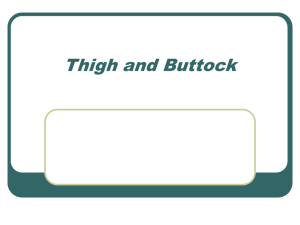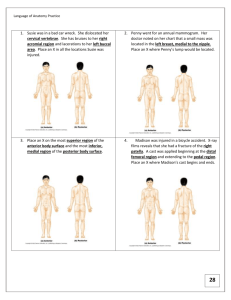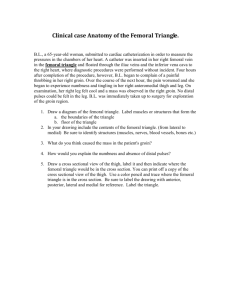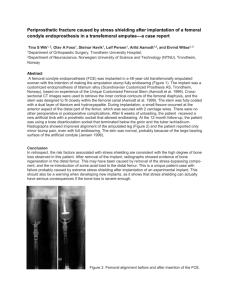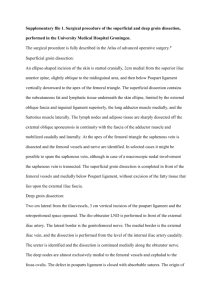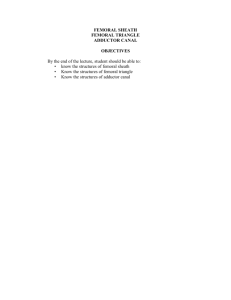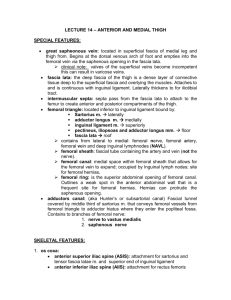Regional anatomy of the lower limb
advertisement
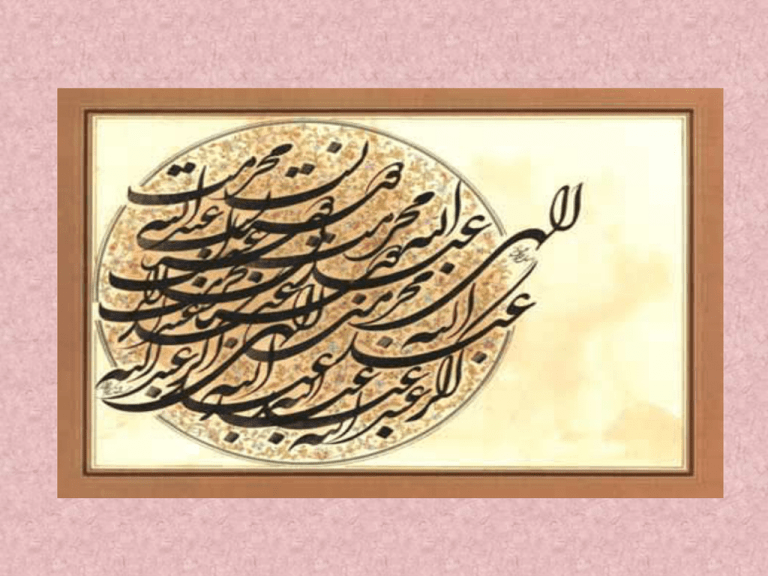
Dr. Banafshe Esmaeilzade, M.S., Ph.D. Deptartment of Anatomy Bushehr Univ. of Medical Sciences Organization of the Lower Limb Limb Development Limb Rotation Regional anatomy of the lower limb Parts and regions of the lower limb • Gluteal region:between iliac crest superiorly and gluteal fold inferiorly • Thigh:between hip and knee • Knee:joint between leg and thigh • Leg:between knee and foot • Ankle • Foot Anterior Region of Thigh Superficial structures: Cutaneous nerves: Femoral branch of jenitofemoral n. Lateral cutaneous n. of thigh Anterior cutaneous n. of thigh medial cutaneous n. of thigh ilioinguinal n. Key dermatomes* of the Lower Limb umbilicus - T10 hip crease - L1 great toe - L4 5th toe - S1 *area of skin supplied by a dorsal nerve root Cutaneous Nerve Innervation of the Lower Limb Superficial arteries: superficial epigastric a. superficial iliac circumflex a. external pudendal a. Superficial veins Superficial epigastric v. Superficial circumflex iliac v. Superficial External pudendal v. Superficial lateral femoral v. Great saphenous v. Superficial inguinal lymph nodes: Horizontal group Vertical group Superficial inguinal lymph nodes Superior group: Lies just distal to the inguinal ligament Receive lymph from anterior abdominal wall below umbilicus, gluteal region, perineal region, external genital organs Inferior group: Lies vertical along the terminal great saphenous v. Receives all superficial lymphatics of lower limb, except for those from the posterolateral part of calf Efferent vessels drain into the deep inguinal ln. or external iliac ln. Fascia of the Lower Limb Gluteal Fascia Fascia Lata Crural Fascia Fascial Compartments of the Thigh anterior compartment Fascia Lata medial compartment posterior compartment Anterior compartment Medial (adductor) compartment Posterior compartment Deep fascia – fascia lata Iliotibial tract Saphenous hiatus falciform margin cribriform fascia Muscles of Hip and Thigh • Gluteals (posterior pelvis) – Extend thigh – Rotate thigh – Abducts thigh • Anterior Compartment Thigh – Flexes thigh at hip – Extends leg at knee • Medial/Adductor Compartment – Adducts thigh – Medially rotates thigh • Posterior Compartment Thigh – Extends thigh – Flexes leg Anterior Compartment muscles of Thigh • Tensor fascia lata – O: iliac crest, A.S.I.S. – I: iliotibial tract – A: Flex thigh, abduct thigh, medial rotation of thigh – N. : Superior Gluteal n. • Sartorius -O – ASIS -I – superior part of medial surface of tibia -A – flexes, abducts, and external rotates thigh -N. Femoral n. • Iliopsoas -O – sides of T12-L5 vertebrae, iliac crest & fossa -I – lesser trochanter of femur, pectineal line -A – flexing the thigh -N- Femoral n. • Quadriceps Femoris 1) Vastus lateralis 2) Vastus medialis 3) Vastus intermedias 4) Rectus femoris – O: femur, – I: patellar ligament – A: Knee extension _ N: Femoral n. pg 299 Rectus femoris – O: A.I.I.S., margin acetabulum – I: patellar ligament – A: Knee extension, flexes thigh • Vastus lateralis -O – greater trochanter and lateral lip of linea aspera of femur • Vastus medialis -O – intertrochanteric line and medial lip of linea aspera of femur • Vastus intermedius -O – anterior and lateral surfaces of body of femur *Same for all 3 -I – base of patella A – helps flex thigh Femoral triangle This triangle is bounded by: superiorly; the inguinal ligament (base) laterally; the medial border of sartorius Medially; the medial border of adductor longus Inferiorly; the apex of the triangle is continuous with adductor canal. The anterior wall is fascia lata The posterior wall consists of adductor longus, pectineus and iliopsoas , from medial to lateral side. Contents of the femoral triangle 1. The femoral artery and its branches,the profunda femoris artery,The lateral and medial circumflex arteries,The deep external pudendal. 2. The femoral vein and its tributaries. 3. Three or four deep inguinal lymph nodes lie along the medial side of the femoral vein. 4. The femoral nerve. 5. The femoral canal. Adductor canal Extends from apex of femoral triangle to adductor hiatus Bounded by : laterally;vastus medialis posteriorly; adductors longus and magmus, anteriorly ;adductor lamina and sartorius Contents – saphenous nerve, femoral a., femoral v., lymphatic vessels, and loose connective tissue The adductor hiatus is a gap in the distal attachment of adductor magnus to the femur, which permits the femoral vessels to pass from the adductor canal downward into the popliteal space. Femoral sheath The femoral sheath is a funnelshaped sheath , derived from transversalis fascia anteriorly and iliac fascia posteriorly. It surroumds the femoral vessels and lymphatic about 2.5cm belower the inguinal ligamemt. Its lower end disappears at the lower margin of the saphenous opening where the sheath fuses with the adventitia of the vessels. The femoral sheath is divided into three compartments by two fibrous septa. The femoral artery occupies the lateral compartment of the sheath. The femoral vein lies the middle compartment. The medial compartment is small, called the femoral canal. The femoral canal It is about 1.3cm long , and its upper opening is called the femoral ring . The boundaries of the femoral ring are:, anteriorly; the inguinal ligamentthe medially; lacunar ligament; , posteriorly; the pecten of pubis laterally; the femoral vein, superiorly; covered by femoral septum. The canal contains a little loose fatty tissue, a small lymph node, and some lymph vessels. Femoral hernia A femoral hernia is common in women than in men (possibly due to a wider pelvis and femoral canal ). If a loop of intestine is forced into the femoral ring, it expands to form a swelling in the upper part of the thigh. Lacuna musculorum Bounded by: anteriorly; lateral portion of inguinal ligament, posterolaterally; ilium Medially; iliopectinal arch Contents: iliopsoas m, femoral n. and lateral femoral cutaneous n. Lateral femoral cutaneous n. Iliopsoas Femoral n. Iliopectinal arch Lacuna vasorum Femoral a. Femoral v. Femoral ring Bounded by: anteriorly,medial portion of inguinal ligament posteromedially, pectineal ligament medially,lacunar ligament , Posterolaterally, iliopectinal arch Contents: femoral sheath, femoral a. and v., genital branch of genitofemoral n. and lymphatic vessels, femoral ring Arteries of lower limb Femoral a. This is the main artery of the lower limb and is directly continuous with the external iliac artery of the abdomen behind the inguinal ligament at the mid- inguinal point. It becomes the popliteal artery by passing through the adductor tendinous opening. Femoral a. Principal branch: 1. Deep femeral a.: arises from the posterolateral surface of the femoral artery about 4 cm below the inguinal ligament. 2. Descending genicular a. 3. Deep external pudendal a. 4. Superficial branches: – superficial epigastric a. – superficial iliac circumflex a. – external pudendal a. Profunda femoris Lateral circumflex artery It arises from the profunda near its origin and runs laterally among the branches of the femoral nerve and then deep to rectus femoris. Here it divides into ascending, transverse, and descending branches. Medial circumflex artery arises either from the profunda near its origin or occasionally direct from the femoral artery. Four perforating arteries Medial circumflex a. Profunda femoral a. Latral circumflex a. Saphenous n. Femoral nerve It arises from the lumbar plexus in the abdomen, and enters the thigh posterior to the inguinal ligament and lateral to the femoral artery. It ends by dividing into a number of branches 2cm below the inguinal ligament. Muscular branche to: pectineus, sartorius, quadriceps femoris Cutaneous nerve branches: (1) Anterior cutaneous nerves of the thigh (medial and lateral). (2) Saphenous nerve is the longest branch of the femoral nerve. It accompanies the femoral vessels in the adductor canal, then accompanies the great saphenous vein to the medial side of the leg and food. Femoral vein This is the direct continuation of the popliteal vein. It begins at the adductor tendinous opening and accompanies the femoral artery to the inguinal ligament behind which it becomes the external iliac vein. The femoral vein contains several valves. Cutaneous Medial compartment Medial compartment muscles • • • • • Adductor longus Adductor brevis Adductor magnus Pectineus Gracilis • Pectineus -O - Superior ramus of pubis -I - Pectineal line of femur -A – adducts and flexes thigh N: Femoral, obturator • Adductor Brevis – O - Inferior Pubic Ramus – I - Pectineal Line and Linea Aspera – A - adducts, flexes, and medially rotates femur • Gracillis – O - pubic Symphysis and inferior pubic ramus – I - medial surface of the tibia – A - adducts thigh, flexes medially and medially rotates thigh, flexes leg – Innervation: Obturator nerve • Adductor Longus – O - med portion of the superior pubic ramus – I - linea aspera of femur – A - adducts, flexes, and medially rotates the femur – Innervation: Obturator nerve • Adductor Magnus – O - ischiopubic ramus and ischial tuberosity – I - linea aspera of the femur; the ischiocondylar part inserts on the adductor tubercle of the femur – A - adducts, flexes, and medially rotates the femur; extends the femur – Innervation: post div of Obturator nerve and tibial n. Nerve and artery • Obturator n. • Accessory obturator n. • Obturator a. • Medial circumflex a. arises either from the profunda near its origin or occasionally direct from the femoral artery. Obturator Nerve Nerve of Medial Fascial Compartment of the Thigh The anterior division passes downward in front of the obturator externus. The posterior division pierces the obturator externus and passes downward behind the adductor brevis and in front of the adductor magnus Lumbar Plexus • Femoral nerve – Cutaneous branches • Thigh, leg, foot (e.g. saphenous nerve) – Motor branches • Anterior thigh muscles (e.g. quadriceps, sartorius, iliopsoas) • Obturator nerve – Sensory • Skin medial thigh; hip, knee joints – Motor • Adductor muscles • Lateral femoral cutaneous – Sensory • Skin lateral thigh • Genitofemoral – Sensory • Skin scrotum, labia major, anterior thigh – Motor • Cremaster muscle
